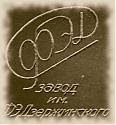| Author |
 Topic Topic  |
|

Milo Schekkerman
Valkir1987
Netherlands
208 Posts |
 Posted - Mar 20 2016 : 09:18:27 AM Posted - Mar 20 2016 : 09:18:27 AM



|
One of my fellow collectors recently got this lens to match up with one of his Fed camera's. Its got brown/yellowish blades like the ones found on the Fed 1B series cameras that I have. The infinity lock is diffirent from other lenses too.
It pitches perfectly on the Fed 1c, although it fits the 1d as well.
I had the chance to see the lens close up today, and the blades and stop appear to be original.



 |
|
Jacques M.
France
2667 Posts |
 Posted - Mar 20 2016 : 12:17:10 PM Posted - Mar 20 2016 : 12:17:10 PM


|
Hi Milo!
As you know, there is no real regularity in the position of the infinity button. All we know is that they should be between 7 and 10 o'clock to allow a good use of the distance ring. I hope you will be satisfied with the position of this blasted button! BTW, what is the s/n of the lens?
I use a 2/5cm Sonnar on my preferred Fed S. The lens ring (on the camera) was turned of 90° clockwise, so that this famous button gets a correct position.
As for the pitch, as far as I know, it is always of 1mm/turn on the early Feds.
Amitiés. Jacques. |
 |
|

Milo Schekkerman
Valkir1987
Netherlands
208 Posts |
 Posted - Mar 20 2016 : 1:08:55 PM Posted - Mar 20 2016 : 1:08:55 PM



|
quote:
As you know, there is no real regularity in the position of the infinity button. All we know is that they should be between 7 and 10 o'clock to allow a good use of the distance ring. I hope you will be satisfied with the position of this blasted button! BTW, what is the s/n of the lens?
I know about the regularity, but I am doubting about it at the moment. It seems every production range has its own matching position. I have constructed a very simple tool to measure this which I will show soon.
But at least the owner is very satisfied with this combination.
Alas no serial number, just a stamp '60' on the back of the ring. Most Fed lenses have blue bladers (1c series) or black blades (late series)
Marks show it has been used a lot, but taken good care of as well. |
 |
|
Jacques M.
France
2667 Posts |
 Posted - Mar 21 2016 : 04:18:17 AM Posted - Mar 21 2016 : 04:18:17 AM


|
quote:
I know about the regularity, but I am doubting about it at the moment. It seems every production range has its own matching position. I have constructed a very simple tool to measure this which I will show soon.
Yes, it's what I think too. But as we don't know how the cameras were produced... So, a regularity by assembly line? By batch? But what is a batch, at Fed's? Does it have a meaning, like at Leica's? I always have the vague belief that things took their place, little by little. And things can be different between plain Fed 1-s and S-s.
Strange that your lens doesn't have the normal s/n.
And eager to see your tool! Sure, we will talk again about these questions when you show it.
Amitiés. Jacques.
|
 |
|

Milo Schekkerman
Valkir1987
Netherlands
208 Posts |
 Posted - Mar 24 2016 : 1:22:28 PM Posted - Mar 24 2016 : 1:22:28 PM



|
Here is the tool. Well... its not really a tool. A trick is more like it. It's quite simple and I shall explain how it works and how you can use it.
You simply need an extension ring that has the same pitch entry on top as beneath. Every lens ring has a black line engraved on 9 o'clock or 270 degrees as seen from the front of the camera.

Fit it on a camera body and mark this spot. I started with a Leica 0 series camera. Next was a Fed 1g which had the same pitch entry.
Then I went through several Fed 1f cameras and a Fed 1d which appeared to have the same entry point.
Following three Fed 1c bodies, which had their pitch entry around the same degree, but earlier than the previous bodies.
Two lasting Fed 1b bodies where the earliest, 180 degrees from the starting point of the 1g.
When the markings are made, you can use this tool to fit a lens onto. You can easily see if your lens will fit a certain body in your collection without having to get al the lenses on and of.
One thing that remains is the fact that each lens needs to be collimated to its working distance on the camera. If you have a set of lenses, choose the one with the shortest working distance to match with the body. The lenses can be shimmed to the same distance. |
Edited by - Valkir1987 on Mar 24 2016 1:30:24 PM |
 |
|
Jacques M.
France
2667 Posts |
 Posted - Apr 02 2016 : 08:34:12 AM Posted - Apr 02 2016 : 08:34:12 AM


|
Thanks, Milo, for your explanation.
After some trials, I cannot find a real regularity when I try on my Feds, with a "tool" like yours, even inside a series;
Anyway, the idea is very interesting. I will check that with all my Fed 1 in some days. After all, I have to remove them from their board to dust all that!
I will tell you.
Amitiés. Jacques.
|
 |
|
| |
 Topic Topic  |
|
